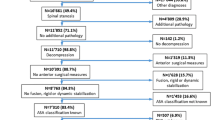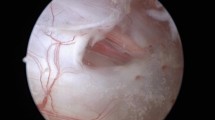Abstract
Introduction
An incidental dural tear (DT) is one of the most common intraoperative complications in lumbar spine surgery. The purpose of this study was to report the incidence of DT in lumbar spinal decompression (LSD) and lumbar discectomy (LD), risk factors, and patient outcomes on a national level.
Materials and methods
Clinical data were obtained from the Nationwide Inpatient Sample for 2009. Patients who underwent LSD for lumbar spinal stenosis and LD for lumbar disc herniation were identified and divided into those with and without DT, according to the International Classification of Diseases, 9th revision, Clinical Modification codes. Patient and healthcare system-related demographic data were retrieved. The incidence of DT and patient outcomes were analyzed. Multiple logistic regression analysis was performed to identify the risk factors for DT.
Results
The incidence of DT was 6.3 % (4,255/67,982) in LSD and 1.9 % (2,564/136,482) in LD. Multivariate analysis revealed that significant risk factors for DT were hypertension and surgery in a teaching hospital for LSD, and older age and male gender for LD. DT was associated with significantly higher overall in-hospital complications (16.4 vs. 8.6 % for LSD, 9.1 vs. 8.0 % for LD). DT increased in-hospital mortality rate for LSD (0.7 vs. 0.1 %), however, not for LD (0.4 vs. 0.2 %). DT was associated with significantly longer hospital stay for LSD (4.6 vs. 3.0 days), however, not for LD (3.24 vs. 3.16 days). DT significantly increased hospital costs ($52,783 vs. $40,454 for LSD, and $32,307 vs. $27,787 for LD).
Conclusions
The incidence of DT was higher in LSD (6.3 %) than in LD (1.9 %), based on a national database. The effect of DT on in-hospital morbidity and mortality and health care burdens was more significant in LSD than in LD.
Similar content being viewed by others
References
Williams BJ, Sansur CA, Smith JS et al (2011) Incidence of unintended durotomy in spine surgery based on 108,478 cases. Neurosurgery 68:117–123
Baker GA, Cizik AM, Bransford RJ et al (2012) Risk factors for unintended durotomy during spine surgery: a multivariate analysis. Spine J 12:121–126
McMahon P, Dididze M, Levi AD (2012) Incidental durotomy after spinal surgery: a prospective study in an academic institution. J Neurosurg Spine 17:30–36
Wang JC, Bohlman HH, Riew DK (1998) Dural tears secondary to operations on the lumbar spine: management and results after a two-year-minimum follow-up of eighty-eight patients. J Bone Joint Surg Am 80:1728–1732
Tafazal SI, Sell PJ (2005) Incidental durotomy in lumbar spine surgery: incidence and management. Eur Spine J 14:287–290
Epstein NE (2007) The frequency and etiology of intraoperative dural tears in 110 predominantly geriatric patients undergoing multilevel laminectomy with noninstrumented fusions. J Spinal Disord Tech 20:380–386
Fu KM, Smith JS, Polly DW Jr et al (2010) Morbidity and mortality in the surgical treatment of 10,329 adults with degenerative lumbar stenosis. J Neurosurg Spine 12:443–446
Desai A, Ball PA, Bekelis K et al (2011) SPORT: does incidental durotomy affect long-term outcomes in cases of spinal stenosis? Neurosurgery 69:38–44
Guerin P, El Fegoun AB, Obeid I et al (2012) Incidental durotomy during spine surgery: incidence, management and complications. A retrospective review. Injury 43:397–401
Strömqvist F, Jönsson B, Strömqvist B, Swedish Society of Spinal Surgeons (2012) Dural lesions in decompression for lumbar spinal stenosis: incidence, risk factors and effect on outcome. Eur Spine J 21:825–828
Takahashi Y, Sato T, Hyodo H et al (2013) Incidental durotomy during lumbar spine surgery: risk factors and anatomic locations: clinical article. J Neurosurg Spine 18:165–169
Radcliff KE, Sidhu GD, Kepler CK et al (2012) Complications of flat bedrest following incidental dural repair. J Spinal Disord Tech Nov 27 [Epub ahead of print]
Stolke D, Sollmann WP, Seifert V (1989) Intra- and postoperative complications in lumbar disc surgery. Spine 14:56–59
Wiese M, Krämer J, Bernsmann K et al (2004) The related outcome and complication rate in primary lumbar microscopic disc surgery depending on the surgeon’s experience: comparative studies. Spine J 4:550–556
Saxler G, Krämer J, Barden B et al (2005) The long-term clinical sequelae of incidental durotomy in lumbar disc surgery. Spine 30:2298–2302
Pechlivanis I, Kuebler M, Harders A et al (2009) Perioperative complication rate of lumbar disc microsurgery depending on the surgeon’s level of training. Cen Eur Neurosurg 70:137–142
Teli M, Lovi A, Brayda-Bruno M et al (2010) Higher risk of dural tears and recurrent herniation with lumbar micro-endoscopic discectomy. Eur Spine J 19:443–450
Strömqvist F, Jönsson B, Strömqvist B, Swedish Society of Spinal Surgeons (2010) Dural lesions in lumbar disc herniation surgery: incidence, risk factors, and outcome. Eur Spine J 19:439–442
Desai A, Ball PA, Bekelis K et al (2011) Outcomes after incidental durotomy during first-time lumbar discectomy. J Neurosurg Spine 14:647–653
Ahn Y, Lee HY, Lee SH et al (2011) Dural tears in percutaneous endoscopic lumbar discectomy. Eur Spine J 20:58–64
Sin AH, Caldito G, Smith D et al (2006) Predictive factors for dural tear and cerebrospinal fluid leakage in patients undergoing lumbar surgery. J Neurosurg Spine 5:224–227
Hannallah D, Lee J, Khan M et al (2008) Cerebrospinal fluid leaks following cervical spine surgery. J Bone Joint Surg Am 90:1101–1105
Ruban D, O’Toole JE (2011) Management of incidental durotomy in minimally invasive spine surgery. Neurosurg Focus 31:E15
Khan MH, Rihn J, Steele G et al (2006) Postoperative management proto- col for incidental dural tears during degenerative lumbar spine surgery: a review of 3,183 consecutive degenerative lumbar cases. Spine 31:2609–2613
Jankowitz BT, Atteberry DS, Gerszten PC et al (2009) Effect of fibrin glue on the prevention of persistent cerebral spinal fluid leakage after incidental durotomy during lumbar spinal surgery. Eur Spine J 18:1169–1174
Bosacco SJ, Gardner MJ, Guille JT (2001) Evaluation and treatment of dural tears in lumbar spine surgery. Clin Orthop 389:238–247
Mayfield FH, Kurokawa K (1975) Watertight closure of spinal dura mater: technical note. J Neurosurg 43:639–640
Mokri B (1999) Spontaneous cerebrospinal fluid leaks: from intracranial hypotension to cerebrospinal fluid hypovolemia—evolution of a concept. Mayo Clin Proc 74:1113–1123
Cammisa FP Jr, Girardi FP, Sangani PK et al (2000) Incidental durotomy in spine surgery. Spine 25:2663–2667
Eismont FJ, Wiesel SW, Rothman RH (1981) Treatment of dural tears associated with spinal surgery. J Bone Joint Surg Am 63:1132–1136
Jones AAM, Stambough JL, Balderston RA et al (1989) Long-term results of lumbar spine surgery complicated by unintended incidental durotomy. Spine 14:443–446
Kitchel SH, Eismont FJ, Green BA (1989) Closed subarachnoid drainage for management of cerebrospinal fluid leakage after an operation on the spine. J Bone Joint Surg Am 71:984–987
Healthcare Cost and Utilization Project (HCUP) (2004) Agency for Health-care Research and Quality. http://www.hcup-us.ahrq.gov/nisoverview.jsp. Accessed 1 Mar 2013
Espiritu MT, Rhyne A, Darden BV 2nd (2010) Dural tears in spine surgery. J Am Acad Orthop Surg 18:537–545
Conflict of interest
None.
Author information
Authors and Affiliations
Corresponding author
Rights and permissions
About this article
Cite this article
Yoshihara, H., Yoneoka, D. Incidental dural tear in lumbar spinal decompression and discectomy: analysis of a nationwide database. Arch Orthop Trauma Surg 133, 1501–1508 (2013). https://doi.org/10.1007/s00402-013-1843-1
Received:
Published:
Issue Date:
DOI: https://doi.org/10.1007/s00402-013-1843-1




